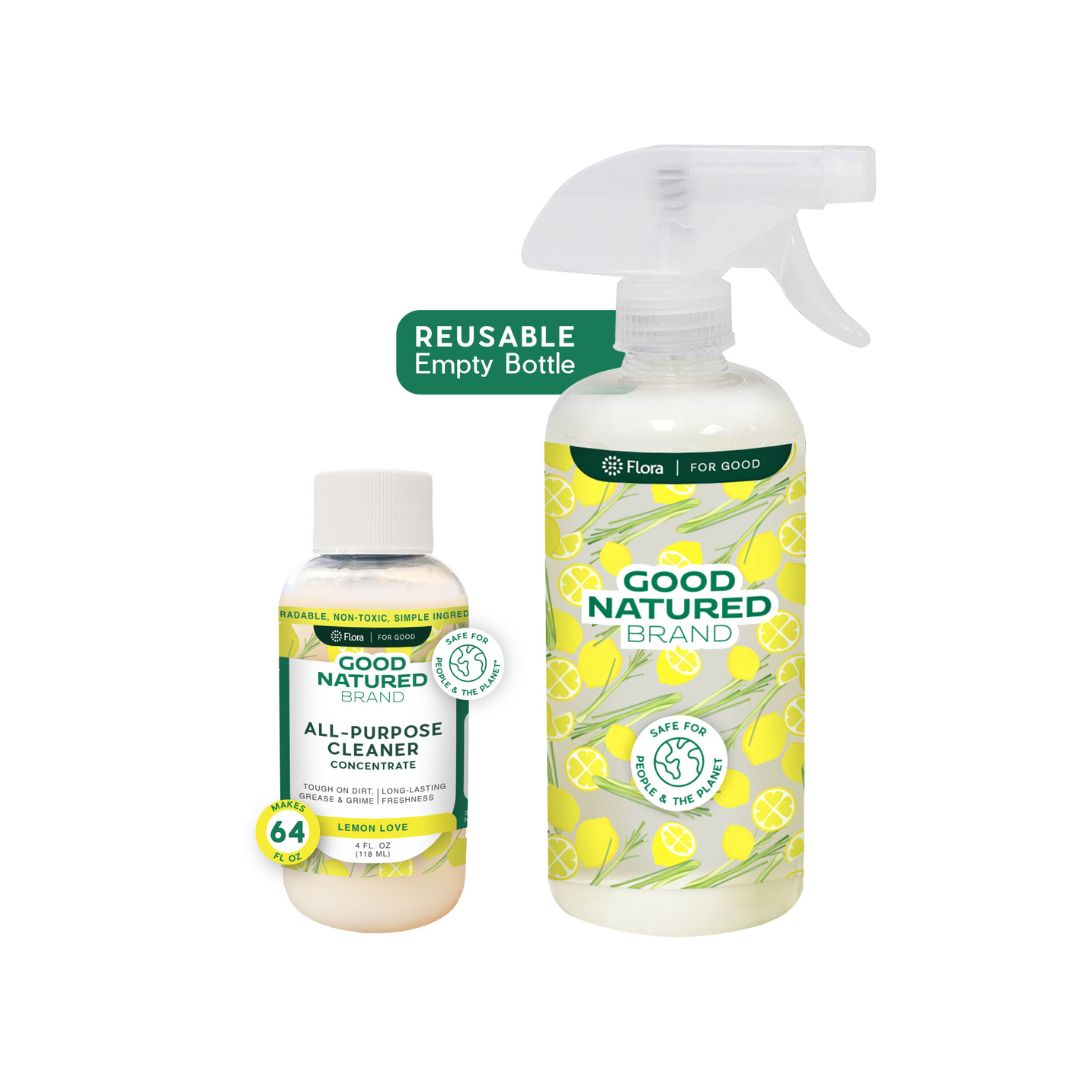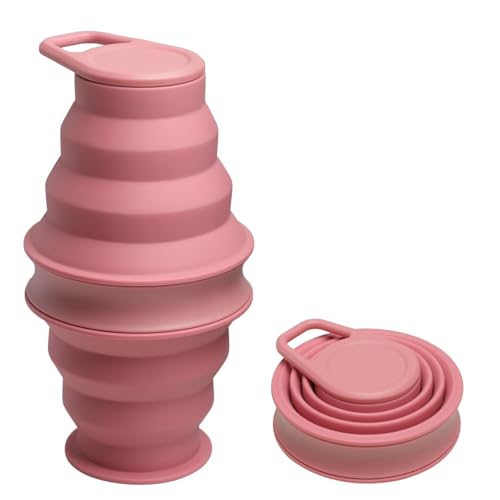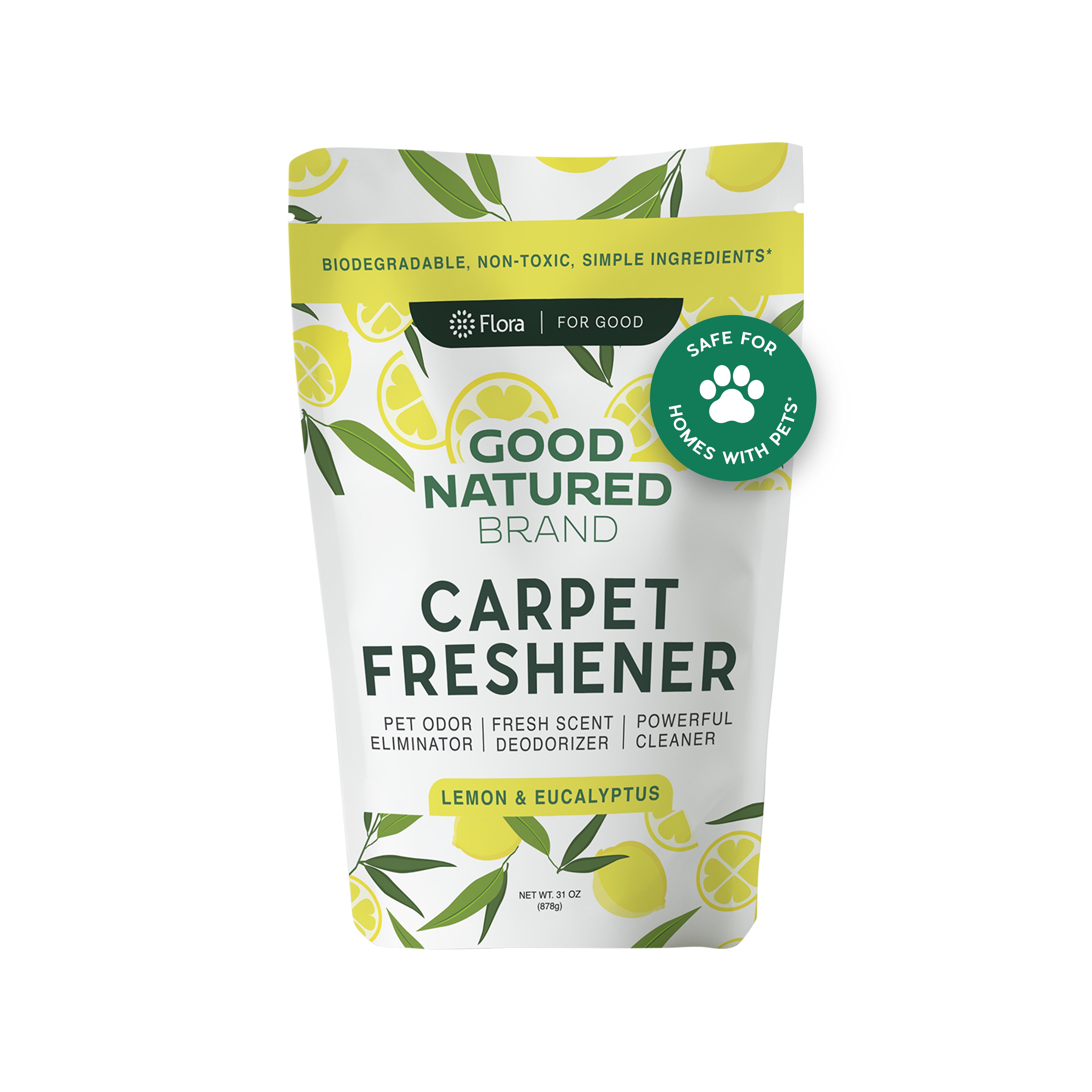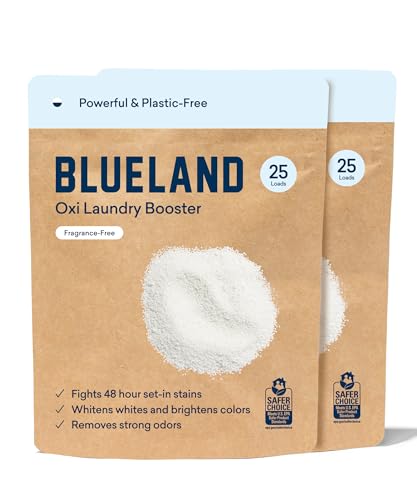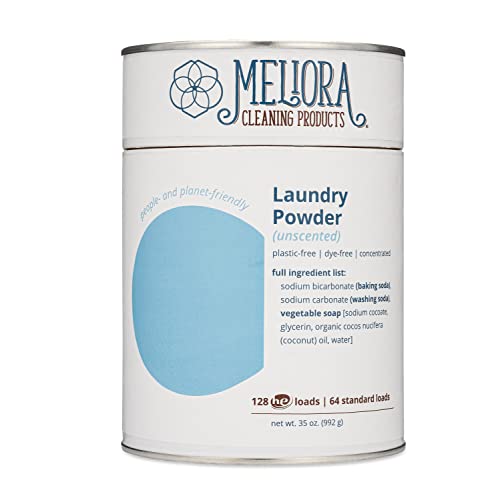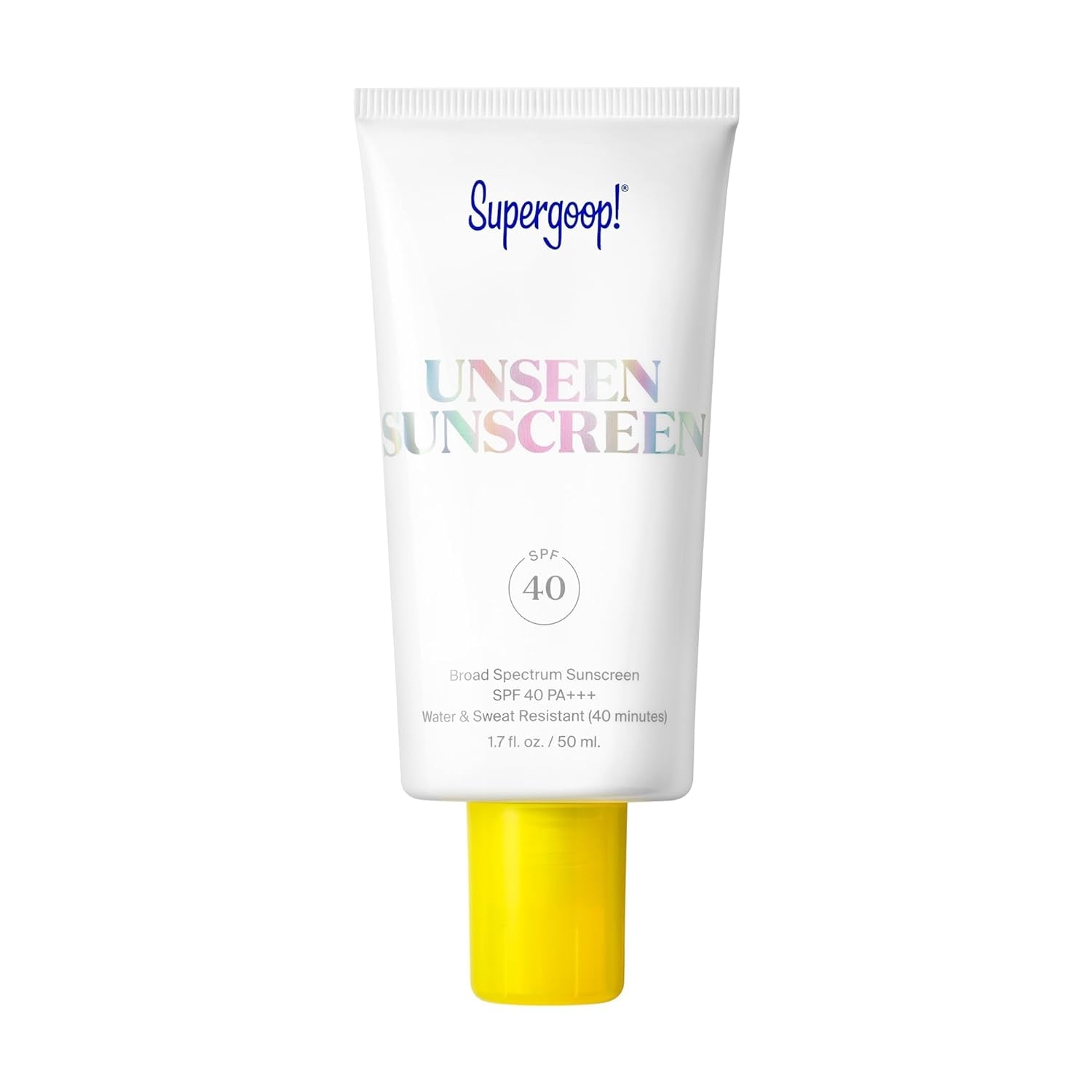
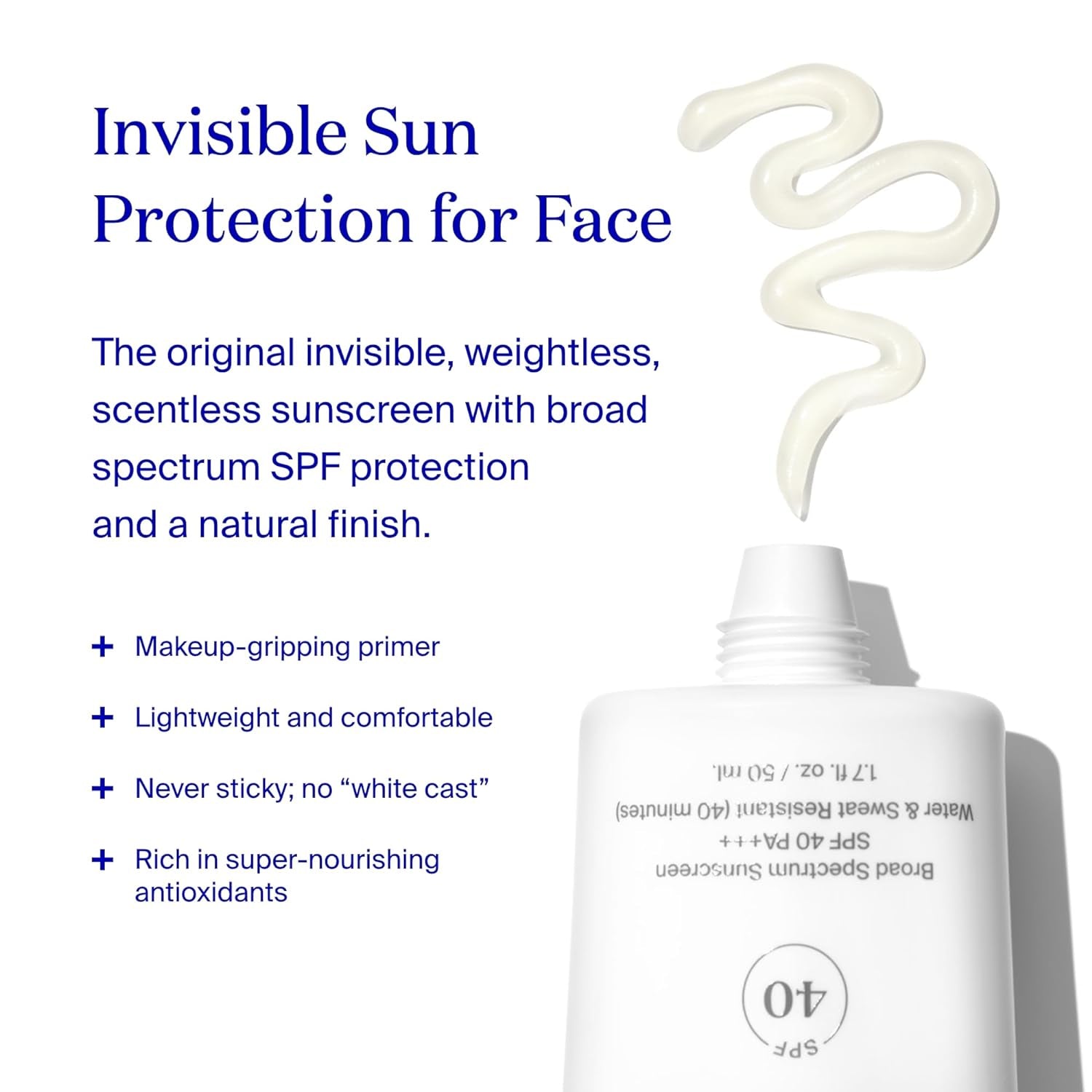

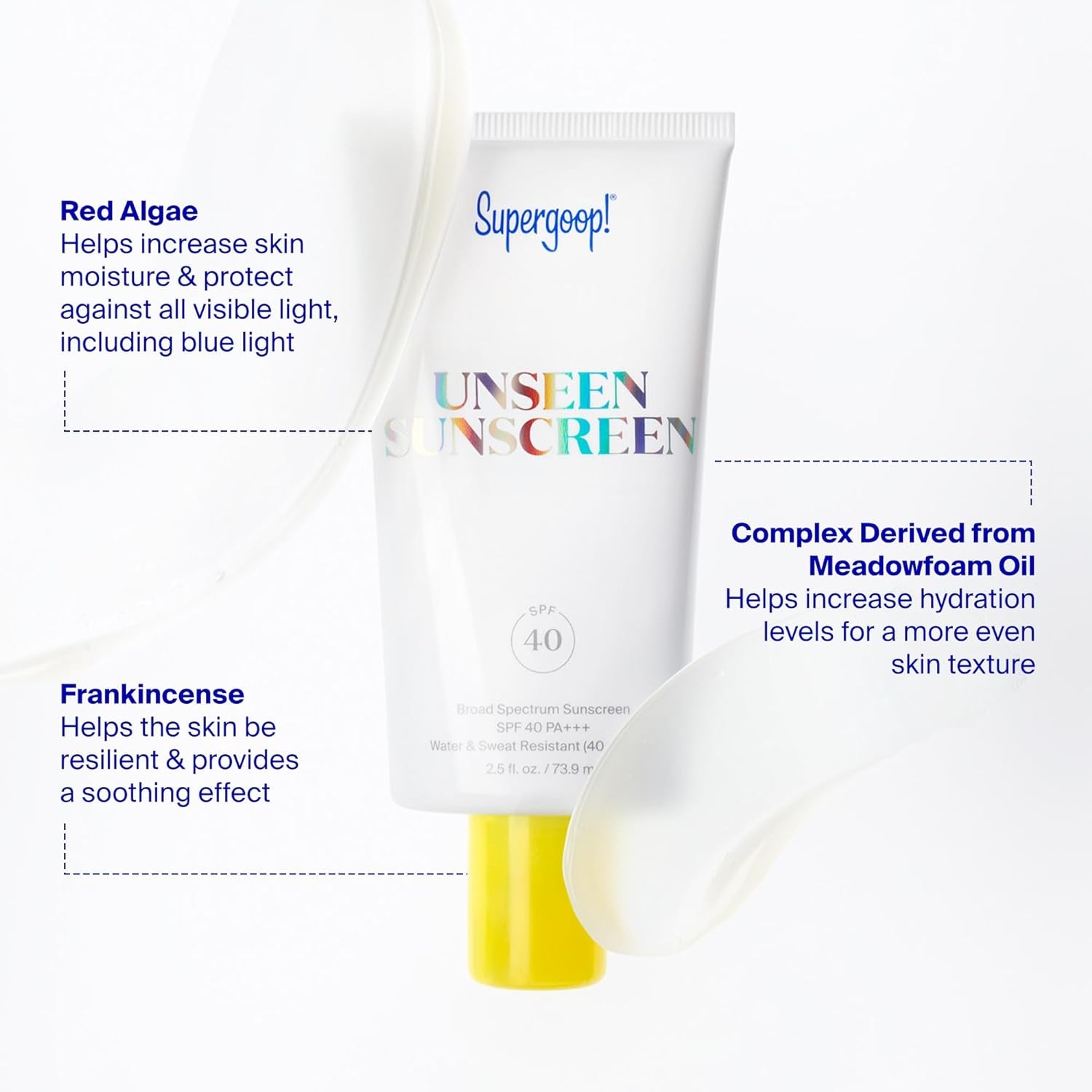
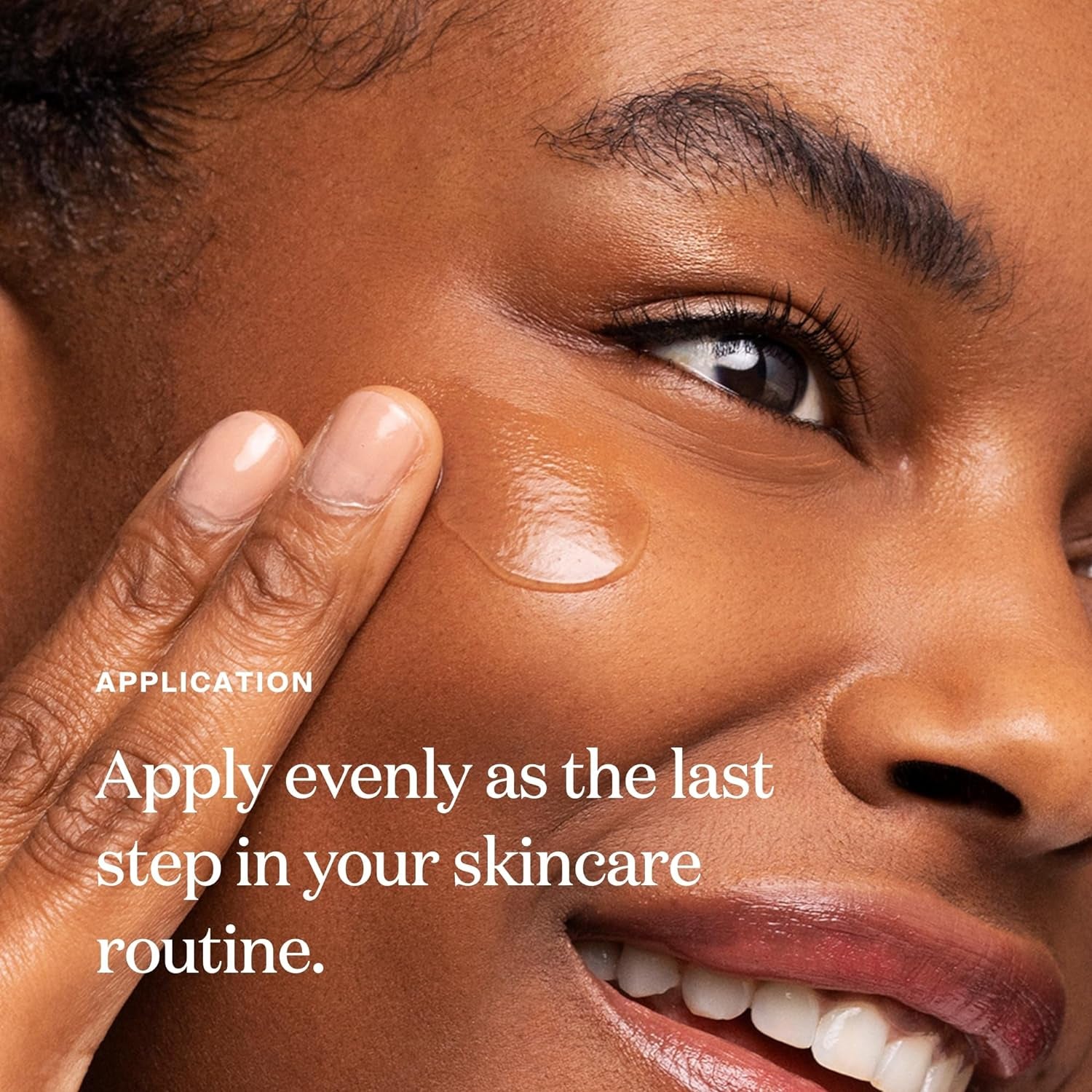

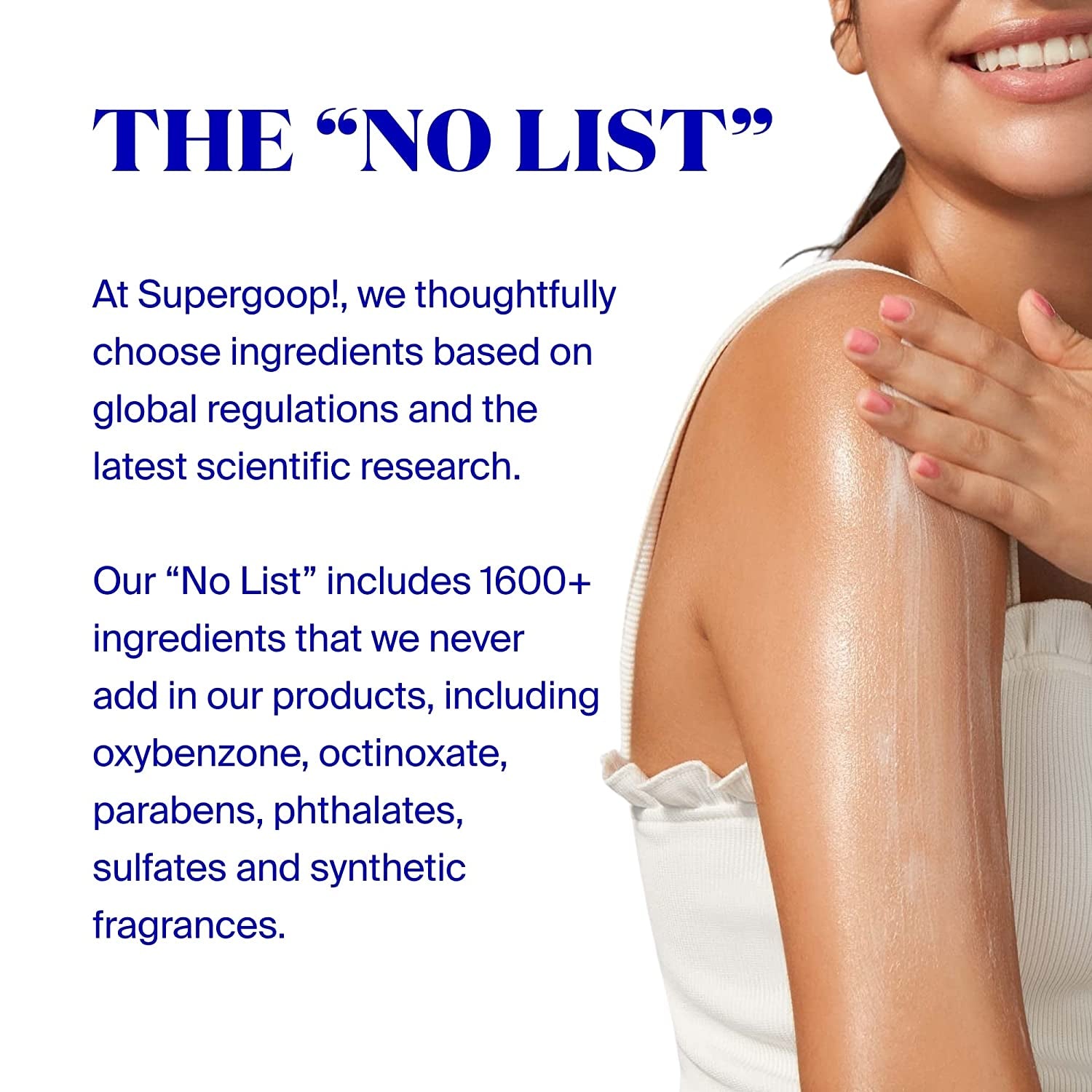
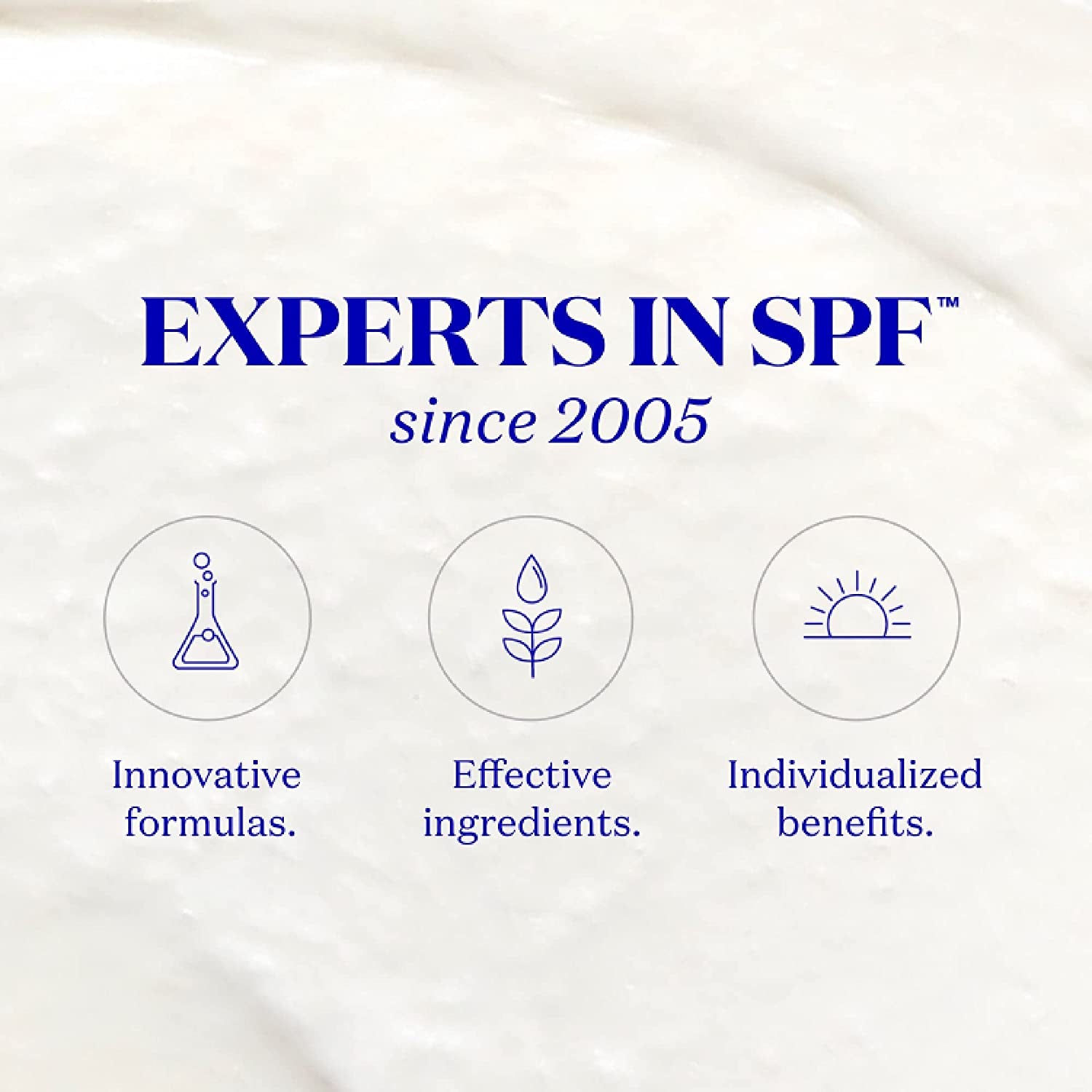
Supergoop! Unseen Sunscreen - SPF 40, Invisible & Weightless, Broad Spectrum - 1.7 fl oz


Zinc Sulfate
High RiskZinc sulfate is an inorganic salt commonly used in various applications, including dietary supplements and agricultural products. It serves as a source of zinc, which is essential for numerous biological functions and plays a role in promoting growth and development.
Sustai Insights
Zinc sulfate offers functional benefits as a zinc source for supplementation, supporting immune function and cellular metabolism. However, it may pose health risks such as skin irritation and gastrointestinal distress in sensitive individuals. Environmental concerns include its potential to contribute to soil and water pollution, along with restrictions on its use in certain products. Regulatory bodies have advised caution regarding its concentration and application, resulting in a high-risk assessment overall. Safe usage practices should be followed, and alternatives such as zinc oxide or organically sourced zinc may be considered.
Homosalate
Medium RiskHomosalate is a synthetic sunscreen ingredient primarily used in cosmetic formulations to absorb UV radiation, providing protection against sun exposure. It is commonly included in sunscreen products and is known for its effectiveness in enhancing the SPF of formulations.
Sustai Insights
Homosalate functions effectively as a UV filter, contributing to sun protection in cosmetic products. However, it is associated with moderate regulatory restrictions and concerns regarding its potential as an endocrine disruptor, though cancer and allergy risks are considered low. Environmental implications include its status as a pollutant, with some risk of bioaccumulation. Regulatory bodies have issued advisories that warrant caution in usage, leading to an overall moderate risk assessment. Safer alternatives may be available for consumers seeking to minimize exposure to this ingredient.
Lecithin
Medium RiskLecithin is a naturally occurring lipid found in various plant and animal tissues, primarily composed of phospholipids. It serves as an emulsifier, stabilizing mixtures of oil and water, and is commonly used in food, cosmetics, and pharmaceuticals to improve texture and extend shelf life.
Sustai Insights
Lecithin provides functional benefits as an effective emulsifier and stabilizer, enhancing product texture while being sustainably sourced from natural origins. Health risks are generally low, with moderate concerns regarding allergies and immunotoxicity but minimal cancer or reproductive toxicity risks. Environmental hazards are limited, and it is not classified as a pollutant. Regulatory bodies impose few restrictions. Overall, lecithin presents a medium risk, suggesting caution in usage, especially for sensitive individuals. Alternatives include sunflower lecithin or other plant-based emulsifiers that may offer similar benefits with reduced allergenic potential.
Octisalate
Medium RiskOctisalate is a weak UVB absorber commonly used in sunscreen formulations to enhance sun protection. It functions by absorbing ultraviolet radiation, thereby preventing sunburn and skin damage. This ingredient is often combined with other UV filters to achieve a broad-spectrum protective effect.
Sustai Insights
Octisalate provides effective UVB protection in sun care products, contributing to skin safety by reducing sunburn risk. Its environmental impact is moderate, with some concerns about its potential as an endocrine disruptor and possible restrictions in specific regions. Health risks are generally low, with low to moderate concerns regarding allergies and immunotoxicity. Regulatory bodies have verified its safe use under certain conditions, leading to an overall moderate risk assessment. For safer alternatives, consider mineral-based UV filters or other approved organic compounds.
Avobenzone
Medium RiskAvobenzone is an organic compound commonly used in sunscreens and skincare products for its ability to absorb ultraviolet (UV) radiation. It provides broad-spectrum protection against UVA rays, helping to prevent skin damage caused by sun exposure. However, it is known to degrade when exposed to sunlight unless stabilized with other ingredients.
Sustai Insights
Avobenzone effectively protects against UVA rays, making it a valuable ingredient in sun care products. However, it has moderate use restrictions due to its instability in sunlight, which can lead to enhanced skin absorption and potential irritation. Regulatory bodies restrict its use in certain formulations, categorizing it as having low concerns for cancer, allergies, and reproductive toxicity. Environmental risks include its potential as a pollutant, though it is not highly bioaccumulative. Overall, the ingredient poses medium risk, and users should adhere to product recommendations for safe application.
Caprylyl Glycol
Low RiskCaprylyl glycol (1,2-octanediol) is a multifunctional cosmetic ingredient primarily used as a skin-conditioning agent and preservative. It is derived from caprylic acid, a fatty acid found in coconut oil, and is commonly included in personal care products for its moisturizing properties.
Sustai Insights
Caprylyl glycol offers functional benefits such as acting as an effective humectant and preservative, enhancing skin hydration and product stability. It is considered to have low health risks, with no significant concerns regarding carcinogenicity, allergies, or reproductive toxicity. Environmentally, it poses minimal risks, being non-bioaccumulative and not linked to pollution. Regulatory assessments affirm its safety, with no major advisories against its use. Overall, the ingredient is assessed to have a low risk, making it a suitable choice in cosmetic formulations.
Mannitol
Low RiskMannitol is a hexahydric alcohol commonly used as a sugar substitute and a humectant in various food and cosmetic products. It naturally occurs in certain fruits and vegetables and is known for its ability to attract and retain moisture.
Sustai Insights
Mannitol serves as an effective humectant and sweetener with low allergenic potential and minimal health risks, such as carcinogenicity or reproductive toxicity. It is generally recognized as safe by regulatory bodies like the FDA. Environmental impacts are low, with no significant pollutant potential or bioaccumulation concerns. Regulatory status remains favorable, though products with mannitol must adhere to specific labeling requirements. Overall, mannitol poses low health and environmental risks, making it a suitable ingredient in various applications.
Cellulose
Low RiskCellulose is a natural polysaccharide derived from plant cell walls, primarily used as a thickening agent, stabilizer, and emulsifier in cosmetic formulations. It is known for its ability to improve texture and consistency in products.
Sustai Insights
Cellulose serves as an effective thickening and stabilizing agent, enhancing product texture while being biodegradable and derived from renewable sources. Health risks are minimal, with low concerns regarding carcinogenicity, allergies, and reproductive toxicity. Environmental impacts are also low, as cellulose does not contribute significantly to pollution or bioaccumulation. Regulatory agencies have not issued restrictions on its use. Overall, cellulose presents a low risk profile, making it a suitable ingredient choice in cosmetics.
Butyrospermum Parkii (Shea) Butter
Low RiskButyrospermum parkii (shea) butter is a vegetable fat derived from the nuts of the shea tree. It is commonly used in cosmetic formulations for its emollient properties, providing moisture and improving skin texture. Additionally, shea butter is known for its ability to enhance the stability of products and deliver a creamy texture.
Sustai Insights
Shea butter offers functional benefits as an effective moisturizer, enhancing skin barrier function and texture. It is sustainably sourced and biodegradable, contributing to eco-friendliness. Health-wise, it is associated with low risks for carcinogenicity, allergies, and reproductive toxicity. Environmental impacts are minimal, with no significant pollutant potential identified. Regulatory assessments indicate no current restrictions. Overall, the ingredient presents a low risk, making it a favorable choice in cosmetic formulations.
Neopentyl Glycol Diheptanoate
Low RiskNeopentyl glycol diheptanoate is a diester of neopentyl glycol and heptanoic acid, primarily used as an emollient and skin-conditioning agent in cosmetic formulations. It enhances the texture and spreadability of products, contributing to a smooth feel on the skin.
Sustai Insights
Neopentyl glycol diheptanoate offers functional benefits as an effective emollient, enhancing product texture and skin feel, while being low in common health concerns such as carcinogenicity and allergens. Environmental risks are minimal, with no significant pollutant or bioaccumulation potential reported. Regulatory status is favorable, with no major restrictions noted. Overall, it poses a low risk to health and the environment. For those seeking alternatives, other emollients with similar properties may be considered.
Tocopherol, D Alpha
Low RiskTocopherol, specifically d-alpha tocopherol, is a naturally occurring form of Vitamin E. It is commonly used in cosmetic and personal care products primarily for its antioxidant properties, helping to protect formulations from oxidation and extend shelf life.
Sustai Insights
D-alpha tocopherol provides effective antioxidant benefits, contributing to product stability. It is sustainably sourced and generally regarded as safe, with low concerns regarding carcinogenicity, allergies, and reproductive toxicity. However, there are minor concerns about endocrine disruption. Regulatory bodies have not imposed significant restrictions, indicating low overall risk. Recommended usage practices include adhering to established safe concentration thresholds. Alternatives, such as other forms of Vitamin E or plant-based antioxidants, may also be considered.
Sand
Low RiskSand is loose, granular particles of worn or disintegrated rock, primarily composed of silica. It is commonly used as an abrasive, filler, or in construction and landscaping for its structural properties.
Sustai Insights
Sand offers functional benefits such as providing bulk and texture in various products, and it is generally considered to have low health risks, with minimal concerns regarding carcinogenicity, allergies, or reproductive toxicity. Environmentally, sand does not contribute significantly to pollution and is not bioaccumulative. Regulatory bodies do not impose restrictions on sand usage, maintaining its low-risk status. Safe usage practices should be followed to avoid inhalation of fine particles. Overall, sand is a low-risk ingredient with no notable negative impacts.
Polymethylsilsesquioxane
Low RiskPolymethylsilsesquioxane is a polymer formed by the condensation of silanol groups. It is commonly used in cosmetic formulations due to its film-forming properties, contributing to texture and smoothness in products such as creams and lotions.
Sustai Insights
Polymethylsilsesquioxane offers functional benefits by enhancing product texture and providing a smooth application. It has a low risk of health concerns, including cancer, allergies, and reproductive toxicity, with minimal irritation potential. Environmentally, it poses low risks as a pollutant and is not bioaccumulative. Regulatory bodies have not placed significant restrictions on its use, indicating a low overall risk level. Safe usage practices should be observed, and while alternatives exist, they may not replicate its unique properties.
Diatomaceous Earth
Low RiskDiatomaceous earth is a mineral material consisting of fossilized remains of tiny, aquatic organisms called diatoms. It is primarily used in various products for its absorbent properties, as well as in applications such as filtration, pest control, and as a thickening agent.
Sustai Insights
Diatomaceous earth serves functional benefits such as effective absorption and filtration. It is generally considered safe with low risks for carcinogenicity, allergies, and reproductive toxicity. However, it has high persistence and bioaccumulation potential, raising environmental concerns. Regulatory bodies impose some restrictions on its use, but overall, it is assessed to pose low risk. Safe usage practices include avoiding inhalation of dust. Alternatives include kaolin clay or other natural absorbents.
Divinyldimethicone
Low RiskDivinyldimethicone is a silicone compound used primarily as a conditioning agent and emollient in cosmetic and personal care products. It enhances the texture and feel of formulations, providing smoothness and a non-greasy finish. Its unique properties make it suitable for various applications, including skin and hair care.
Sustai Insights
Divinyldimethicone offers functional benefits, such as improving product smoothness and enhancing moisture retention. It has a low risk of health concerns, including low potential for carcinogenicity, allergies, and reproductive toxicity. Environmental risks are minimal, although contamination concerns exist. Regulatory status is generally favorable, with no significant restrictions noted. Overall risk assessment is low, making it a viable ingredient in personal care formulations. Safe usage practices should be followed, although alternatives may include other silicone-based compounds that provide similar benefits.
Isododecane
Low RiskIsododecane is a branched chain aliphatic hydrocarbon, primarily used in cosmetic formulations for its ability to enhance texture and improve product spreadability. It serves as a solvent and emollient, contributing to the overall performance of formulations, particularly in products designed for long-lasting wear.
Sustai Insights
Isododecane offers functional benefits such as enhancing product texture and longevity. It is associated with low health risks, including low potential for carcinogenicity, allergies, and neurotoxicity. Environmentally, it poses minimal risks as it is not bioaccumulative. Regulatory oversight indicates it is restricted in certain products, ensuring safety compliance. Overall, the risk level associated with isododecane is low, making it a relatively safe option in cosmetic formulations. Alternatives may include natural emollients for those seeking greener options.
Jojoba Esters
Low RiskJojoba esters are a complex mixture of esters produced from the oil of the jojoba plant (Simmondsia chinensis). They serve primarily as emollients and skin conditioning agents in cosmetic formulations, enhancing texture and moisture retention.
Sustai Insights
Jojoba esters provide effective moisturizing properties, contributing to skin conditioning and improving product feel. They are sustainably sourced and biodegradable, posing low risk for carcinogenicity, allergies, and developmental toxicity. Environmental risks are minimal, with no significant pollutants or bioaccumulation concerns. Regulatory agencies have not imposed restrictions, indicating a low overall risk assessment. Safe usage practices should include monitoring for any allergic reactions, although such occurrences are rare. Alternatives, such as synthetic emollients, may be considered, but jojoba esters remain a low-risk option.
Isohexadecane
Low RiskIsohexadecane is a branched chain hydrocarbon used in cosmetic formulations primarily as a solvent, emollient, and skin-conditioning agent. It enhances the spreadability of products and provides a lightweight, non-greasy feel on the skin.
Sustai Insights
Isohexadecane offers functional benefits by improving product texture and absorption while being non-irritating, with low concerns regarding cancer, allergies, and reproductive toxicity. Environmentally, it poses minimal risks, as it is not known to be a significant pollutant or bioaccumulative. Regulatory assessments indicate no current restrictions, supporting its safe use in cosmetics. Overall, isohexadecane presents a low risk, making it a suitable ingredient in personal care products.
Dicapryl Carbonate
Low RiskDicapryl carbonate is an ester derived from caprylic acid and carbonic acid. It is used primarily as an emollient and skin conditioning agent in cosmetic formulations, providing a smooth and soft feel to the skin.
Sustai Insights
Dicapryl carbonate serves as an effective emollient, enhancing the texture of skincare products. It is biodegradable and sustainably sourced, contributing positively to environmental sustainability. Health risks are minimal, with low concerns for cancer, allergies, or reproductive toxicity. There are no significant environmental hazards associated with its use, and it is not subject to regulatory restrictions. Overall, the ingredient presents a low risk profile, making it a favorable choice in cosmetic applications.
Caprylic Triglyceride
Low RiskCaprylic triglyceride is an ester derived from coconut oil and glycerin, commonly used in cosmetic formulations as an emollient, stabilizer, and skin-conditioning agent. It helps to improve the texture and spreadability of products while providing a lightweight, non-greasy feel.
Sustai Insights
Caprylic triglyceride offers functional benefits such as enhanced skin moisturization and improved formulation stability. It is generally regarded as safe, with low concerns regarding carcinogenicity, allergenic potential, and reproductive toxicity. Environmental impact is minimal, with no significant pollutant or bioaccumulative properties identified. Regulatory bodies have not issued warnings or restrictions. Overall, the risk level is low, making it a suitable ingredient in cosmetic products. Safe usage practices include adhering to recommended concentrations, and while there are alternatives, caprylic triglyceride remains a reliable choice.
Meadowfoam Estolide
Low RiskMeadowfoam estolide is an oligomeric ester derived from meadowfoam seed oil, commonly used in cosmetic formulations for its emollient properties. It acts as a moisturizing agent, helping to improve skin texture and retain moisture in various personal care products.
Sustai Insights
Meadowfoam estolide offers effective moisturizing benefits, enhancing skin hydration and texture while being sustainably sourced. Health risks are minimal, with low concerns regarding carcinogenicity, allergies, and reproductive toxicity. Environmental impacts are also low, with no significant pollutant or bioaccumulation potential noted. Regulatory bodies have not issued warnings, affirming its safety. Overall, it presents a low risk profile, making it a suitable ingredient option. For those seeking alternatives, other natural esters could be considered for similar functional benefits.
Diethylhexyl 2,6 Naphthalate
Low RiskDiethylhexyl 2,6 naphthalate is a phthalate compound primarily used as a plasticizer in various products, enhancing flexibility and durability. It is commonly found in materials such as plastics, adhesives, and coatings, contributing to product performance.
Sustai Insights
Diethylhexyl 2,6 naphthalate serves as an effective plasticizer, improving the workability and longevity of materials. While it has low concerns regarding cancer, allergies, and reproductive toxicity, there are moderate risks related to cumulative exposure from multiple sources. Environmentally, it is not classified as bioaccumulative or a significant pollutant. Regulatory bodies currently do not impose restrictions on its use. Overall, the risk level is considered low, and safer alternatives may include other biodegradable plasticizers.
Caprylyl Glycol
Low RiskCaprylyl glycol (1,2-octanediol) is a multifunctional cosmetic ingredient primarily used as a skin-conditioning agent and preservative. It is derived from caprylic acid, a fatty acid found in coconut oil, and is commonly included in personal care products for its moisturizing properties.
Sustai Insights
Caprylyl glycol offers functional benefits such as acting as an effective humectant and preservative, enhancing skin hydration and product stability. It is considered to have low health risks, with no significant concerns regarding carcinogenicity, allergies, or reproductive toxicity. Environmentally, it poses minimal risks, being non-bioaccumulative and not linked to pollution. Regulatory assessments affirm its safety, with no major advisories against its use. Overall, the ingredient is assessed to have a low risk, making it a suitable choice in cosmetic formulations.
Mannitol
Low RiskMannitol is a hexahydric alcohol commonly used as a sugar substitute and a humectant in various food and cosmetic products. It naturally occurs in certain fruits and vegetables and is known for its ability to attract and retain moisture.
Sustai Insights
Mannitol serves as an effective humectant and sweetener with low allergenic potential and minimal health risks, such as carcinogenicity or reproductive toxicity. It is generally recognized as safe by regulatory bodies like the FDA. Environmental impacts are low, with no significant pollutant potential or bioaccumulation concerns. Regulatory status remains favorable, though products with mannitol must adhere to specific labeling requirements. Overall, mannitol poses low health and environmental risks, making it a suitable ingredient in various applications.
Cellulose
Low RiskCellulose is a natural polysaccharide derived from plant cell walls, primarily used as a thickening agent, stabilizer, and emulsifier in cosmetic formulations. It is known for its ability to improve texture and consistency in products.
Sustai Insights
Cellulose serves as an effective thickening and stabilizing agent, enhancing product texture while being biodegradable and derived from renewable sources. Health risks are minimal, with low concerns regarding carcinogenicity, allergies, and reproductive toxicity. Environmental impacts are also low, as cellulose does not contribute significantly to pollution or bioaccumulation. Regulatory agencies have not issued restrictions on its use. Overall, cellulose presents a low risk profile, making it a suitable ingredient choice in cosmetics.
Butyrospermum Parkii (Shea) Butter
Low RiskButyrospermum parkii (shea) butter is a vegetable fat derived from the nuts of the shea tree. It is commonly used in cosmetic formulations for its emollient properties, providing moisture and improving skin texture. Additionally, shea butter is known for its ability to enhance the stability of products and deliver a creamy texture.
Sustai Insights
Shea butter offers functional benefits as an effective moisturizer, enhancing skin barrier function and texture. It is sustainably sourced and biodegradable, contributing to eco-friendliness. Health-wise, it is associated with low risks for carcinogenicity, allergies, and reproductive toxicity. Environmental impacts are minimal, with no significant pollutant potential identified. Regulatory assessments indicate no current restrictions. Overall, the ingredient presents a low risk, making it a favorable choice in cosmetic formulations.
Neopentyl Glycol Diheptanoate
Low RiskNeopentyl glycol diheptanoate is a diester of neopentyl glycol and heptanoic acid, primarily used as an emollient and skin-conditioning agent in cosmetic formulations. It enhances the texture and spreadability of products, contributing to a smooth feel on the skin.
Sustai Insights
Neopentyl glycol diheptanoate offers functional benefits as an effective emollient, enhancing product texture and skin feel, while being low in common health concerns such as carcinogenicity and allergens. Environmental risks are minimal, with no significant pollutant or bioaccumulation potential reported. Regulatory status is favorable, with no major restrictions noted. Overall, it poses a low risk to health and the environment. For those seeking alternatives, other emollients with similar properties may be considered.
Tocopherol, D Alpha
Low RiskTocopherol, specifically d-alpha tocopherol, is a naturally occurring form of Vitamin E. It is commonly used in cosmetic and personal care products primarily for its antioxidant properties, helping to protect formulations from oxidation and extend shelf life.
Sustai Insights
D-alpha tocopherol provides effective antioxidant benefits, contributing to product stability. It is sustainably sourced and generally regarded as safe, with low concerns regarding carcinogenicity, allergies, and reproductive toxicity. However, there are minor concerns about endocrine disruption. Regulatory bodies have not imposed significant restrictions, indicating low overall risk. Recommended usage practices include adhering to established safe concentration thresholds. Alternatives, such as other forms of Vitamin E or plant-based antioxidants, may also be considered.
Sand
Low RiskSand is loose, granular particles of worn or disintegrated rock, primarily composed of silica. It is commonly used as an abrasive, filler, or in construction and landscaping for its structural properties.
Sustai Insights
Sand offers functional benefits such as providing bulk and texture in various products, and it is generally considered to have low health risks, with minimal concerns regarding carcinogenicity, allergies, or reproductive toxicity. Environmentally, sand does not contribute significantly to pollution and is not bioaccumulative. Regulatory bodies do not impose restrictions on sand usage, maintaining its low-risk status. Safe usage practices should be followed to avoid inhalation of fine particles. Overall, sand is a low-risk ingredient with no notable negative impacts.
Polymethylsilsesquioxane
Low RiskPolymethylsilsesquioxane is a polymer formed by the condensation of silanol groups. It is commonly used in cosmetic formulations due to its film-forming properties, contributing to texture and smoothness in products such as creams and lotions.
Sustai Insights
Polymethylsilsesquioxane offers functional benefits by enhancing product texture and providing a smooth application. It has a low risk of health concerns, including cancer, allergies, and reproductive toxicity, with minimal irritation potential. Environmentally, it poses low risks as a pollutant and is not bioaccumulative. Regulatory bodies have not placed significant restrictions on its use, indicating a low overall risk level. Safe usage practices should be observed, and while alternatives exist, they may not replicate its unique properties.
Diatomaceous Earth
Low RiskDiatomaceous earth is a mineral material consisting of fossilized remains of tiny, aquatic organisms called diatoms. It is primarily used in various products for its absorbent properties, as well as in applications such as filtration, pest control, and as a thickening agent.
Sustai Insights
Diatomaceous earth serves functional benefits such as effective absorption and filtration. It is generally considered safe with low risks for carcinogenicity, allergies, and reproductive toxicity. However, it has high persistence and bioaccumulation potential, raising environmental concerns. Regulatory bodies impose some restrictions on its use, but overall, it is assessed to pose low risk. Safe usage practices include avoiding inhalation of dust. Alternatives include kaolin clay or other natural absorbents.
Homosalate
Medium RiskHomosalate is a synthetic sunscreen ingredient primarily used in cosmetic formulations to absorb UV radiation, providing protection against sun exposure. It is commonly included in sunscreen products and is known for its effectiveness in enhancing the SPF of formulations.
Sustai Insights
Homosalate functions effectively as a UV filter, contributing to sun protection in cosmetic products. However, it is associated with moderate regulatory restrictions and concerns regarding its potential as an endocrine disruptor, though cancer and allergy risks are considered low. Environmental implications include its status as a pollutant, with some risk of bioaccumulation. Regulatory bodies have issued advisories that warrant caution in usage, leading to an overall moderate risk assessment. Safer alternatives may be available for consumers seeking to minimize exposure to this ingredient.
Lecithin
Medium RiskLecithin is a naturally occurring lipid found in various plant and animal tissues, primarily composed of phospholipids. It serves as an emulsifier, stabilizing mixtures of oil and water, and is commonly used in food, cosmetics, and pharmaceuticals to improve texture and extend shelf life.
Sustai Insights
Lecithin provides functional benefits as an effective emulsifier and stabilizer, enhancing product texture while being sustainably sourced from natural origins. Health risks are generally low, with moderate concerns regarding allergies and immunotoxicity but minimal cancer or reproductive toxicity risks. Environmental hazards are limited, and it is not classified as a pollutant. Regulatory bodies impose few restrictions. Overall, lecithin presents a medium risk, suggesting caution in usage, especially for sensitive individuals. Alternatives include sunflower lecithin or other plant-based emulsifiers that may offer similar benefits with reduced allergenic potential.
Octisalate
Medium RiskOctisalate is a weak UVB absorber commonly used in sunscreen formulations to enhance sun protection. It functions by absorbing ultraviolet radiation, thereby preventing sunburn and skin damage. This ingredient is often combined with other UV filters to achieve a broad-spectrum protective effect.
Sustai Insights
Octisalate provides effective UVB protection in sun care products, contributing to skin safety by reducing sunburn risk. Its environmental impact is moderate, with some concerns about its potential as an endocrine disruptor and possible restrictions in specific regions. Health risks are generally low, with low to moderate concerns regarding allergies and immunotoxicity. Regulatory bodies have verified its safe use under certain conditions, leading to an overall moderate risk assessment. For safer alternatives, consider mineral-based UV filters or other approved organic compounds.
Divinyldimethicone
Low RiskDivinyldimethicone is a silicone compound used primarily as a conditioning agent and emollient in cosmetic and personal care products. It enhances the texture and feel of formulations, providing smoothness and a non-greasy finish. Its unique properties make it suitable for various applications, including skin and hair care.
Sustai Insights
Divinyldimethicone offers functional benefits, such as improving product smoothness and enhancing moisture retention. It has a low risk of health concerns, including low potential for carcinogenicity, allergies, and reproductive toxicity. Environmental risks are minimal, although contamination concerns exist. Regulatory status is generally favorable, with no significant restrictions noted. Overall risk assessment is low, making it a viable ingredient in personal care formulations. Safe usage practices should be followed, although alternatives may include other silicone-based compounds that provide similar benefits.
Isododecane
Low RiskIsododecane is a branched chain aliphatic hydrocarbon, primarily used in cosmetic formulations for its ability to enhance texture and improve product spreadability. It serves as a solvent and emollient, contributing to the overall performance of formulations, particularly in products designed for long-lasting wear.
Sustai Insights
Isododecane offers functional benefits such as enhancing product texture and longevity. It is associated with low health risks, including low potential for carcinogenicity, allergies, and neurotoxicity. Environmentally, it poses minimal risks as it is not bioaccumulative. Regulatory oversight indicates it is restricted in certain products, ensuring safety compliance. Overall, the risk level associated with isododecane is low, making it a relatively safe option in cosmetic formulations. Alternatives may include natural emollients for those seeking greener options.
Avobenzone
Medium RiskAvobenzone is an organic compound commonly used in sunscreens and skincare products for its ability to absorb ultraviolet (UV) radiation. It provides broad-spectrum protection against UVA rays, helping to prevent skin damage caused by sun exposure. However, it is known to degrade when exposed to sunlight unless stabilized with other ingredients.
Sustai Insights
Avobenzone effectively protects against UVA rays, making it a valuable ingredient in sun care products. However, it has moderate use restrictions due to its instability in sunlight, which can lead to enhanced skin absorption and potential irritation. Regulatory bodies restrict its use in certain formulations, categorizing it as having low concerns for cancer, allergies, and reproductive toxicity. Environmental risks include its potential as a pollutant, though it is not highly bioaccumulative. Overall, the ingredient poses medium risk, and users should adhere to product recommendations for safe application.
Jojoba Esters
Low RiskJojoba esters are a complex mixture of esters produced from the oil of the jojoba plant (Simmondsia chinensis). They serve primarily as emollients and skin conditioning agents in cosmetic formulations, enhancing texture and moisture retention.
Sustai Insights
Jojoba esters provide effective moisturizing properties, contributing to skin conditioning and improving product feel. They are sustainably sourced and biodegradable, posing low risk for carcinogenicity, allergies, and developmental toxicity. Environmental risks are minimal, with no significant pollutants or bioaccumulation concerns. Regulatory agencies have not imposed restrictions, indicating a low overall risk assessment. Safe usage practices should include monitoring for any allergic reactions, although such occurrences are rare. Alternatives, such as synthetic emollients, may be considered, but jojoba esters remain a low-risk option.
Isohexadecane
Low RiskIsohexadecane is a branched chain hydrocarbon used in cosmetic formulations primarily as a solvent, emollient, and skin-conditioning agent. It enhances the spreadability of products and provides a lightweight, non-greasy feel on the skin.
Sustai Insights
Isohexadecane offers functional benefits by improving product texture and absorption while being non-irritating, with low concerns regarding cancer, allergies, and reproductive toxicity. Environmentally, it poses minimal risks, as it is not known to be a significant pollutant or bioaccumulative. Regulatory assessments indicate no current restrictions, supporting its safe use in cosmetics. Overall, isohexadecane presents a low risk, making it a suitable ingredient in personal care products.
Dicapryl Carbonate
Low RiskDicapryl carbonate is an ester derived from caprylic acid and carbonic acid. It is used primarily as an emollient and skin conditioning agent in cosmetic formulations, providing a smooth and soft feel to the skin.
Sustai Insights
Dicapryl carbonate serves as an effective emollient, enhancing the texture of skincare products. It is biodegradable and sustainably sourced, contributing positively to environmental sustainability. Health risks are minimal, with low concerns for cancer, allergies, or reproductive toxicity. There are no significant environmental hazards associated with its use, and it is not subject to regulatory restrictions. Overall, the ingredient presents a low risk profile, making it a favorable choice in cosmetic applications.
Zinc Sulfate
High RiskZinc sulfate is an inorganic salt commonly used in various applications, including dietary supplements and agricultural products. It serves as a source of zinc, which is essential for numerous biological functions and plays a role in promoting growth and development.
Sustai Insights
Zinc sulfate offers functional benefits as a zinc source for supplementation, supporting immune function and cellular metabolism. However, it may pose health risks such as skin irritation and gastrointestinal distress in sensitive individuals. Environmental concerns include its potential to contribute to soil and water pollution, along with restrictions on its use in certain products. Regulatory bodies have advised caution regarding its concentration and application, resulting in a high-risk assessment overall. Safe usage practices should be followed, and alternatives such as zinc oxide or organically sourced zinc may be considered.
Caprylic Triglyceride
Low RiskCaprylic triglyceride is an ester derived from coconut oil and glycerin, commonly used in cosmetic formulations as an emollient, stabilizer, and skin-conditioning agent. It helps to improve the texture and spreadability of products while providing a lightweight, non-greasy feel.
Sustai Insights
Caprylic triglyceride offers functional benefits such as enhanced skin moisturization and improved formulation stability. It is generally regarded as safe, with low concerns regarding carcinogenicity, allergenic potential, and reproductive toxicity. Environmental impact is minimal, with no significant pollutant or bioaccumulative properties identified. Regulatory bodies have not issued warnings or restrictions. Overall, the risk level is low, making it a suitable ingredient in cosmetic products. Safe usage practices include adhering to recommended concentrations, and while there are alternatives, caprylic triglyceride remains a reliable choice.
Meadowfoam Estolide
Low RiskMeadowfoam estolide is an oligomeric ester derived from meadowfoam seed oil, commonly used in cosmetic formulations for its emollient properties. It acts as a moisturizing agent, helping to improve skin texture and retain moisture in various personal care products.
Sustai Insights
Meadowfoam estolide offers effective moisturizing benefits, enhancing skin hydration and texture while being sustainably sourced. Health risks are minimal, with low concerns regarding carcinogenicity, allergies, and reproductive toxicity. Environmental impacts are also low, with no significant pollutant or bioaccumulation potential noted. Regulatory bodies have not issued warnings, affirming its safety. Overall, it presents a low risk profile, making it a suitable ingredient option. For those seeking alternatives, other natural esters could be considered for similar functional benefits.
Diethylhexyl 2,6 Naphthalate
Low RiskDiethylhexyl 2,6 naphthalate is a phthalate compound primarily used as a plasticizer in various products, enhancing flexibility and durability. It is commonly found in materials such as plastics, adhesives, and coatings, contributing to product performance.
Sustai Insights
Diethylhexyl 2,6 naphthalate serves as an effective plasticizer, improving the workability and longevity of materials. While it has low concerns regarding cancer, allergies, and reproductive toxicity, there are moderate risks related to cumulative exposure from multiple sources. Environmentally, it is not classified as bioaccumulative or a significant pollutant. Regulatory bodies currently do not impose restrictions on its use. Overall, the risk level is considered low, and safer alternatives may include other biodegradable plasticizers.
Experience the revolutionary Supergoop! Unseen Sunscreen, a game-changing SPF 40 formula designed for all skin types and tones. This invisible, weightless, and scentless sunscreen offers broad-spectrum protection while enhancing your skincare routine.
- Comprehensive Protection: Shields against UVA, UVB, and IRA rays, plus blue light from screens, safeguarding your skin from environmental damage.
- Oil-Free & Lightweight: The unique formula glides on effortlessly, providing shine control with a velvety finish, making it perfect as a makeup primer.
- Nourishing Ingredients: Infused with clean, skin-loving ingredients like frankincense and meadowfoam seed for hydration and protection without harmful chemicals.
- Beard-Friendly Texture: Ideal for everyone, this clear sunscreen feels like nothing on the skin, ensuring a comfortable wear even for those with facial hair.
- Eco-Conscious Choice: Oxybenzone- and octinoxate-free, this sunscreen is formulated with environmentally safe ingredients, empowering consumers to make informed choices for their skin and the planet.
Subscribe & Save with Sustai
- Best Price Guarantee: Always enjoy the lowest prices on sustainable home essentials.
- No Surprises: We’ll notify you before shipping. No hidden fees, ever.
- You’re in Charge: Change, pause, or cancel your subscription anytime with ease.
- Eco-Friendly Deliveries: Our grouped shipments mean less packaging and lower emissions.
Join us on a sustainable journey. Special offers for a limited time! Prices and promotions may change.
Recommended Products
Experience the revolutionary Supergoop! Unseen Sunscreen, a game-changing SPF 40 formula designed for all skin types and tones. This invisible, weightless, and scentless sunscreen offers broad-spectrum protection while enhancing your skincare routine.
- Comprehensive Protection: Shields against UVA, UVB, and IRA rays, plus blue light from screens, safeguarding your skin from environmental damage.
- Oil-Free & Lightweight: The unique formula glides on effortlessly, providing shine control with a velvety finish, making it perfect as a makeup primer.
- Nourishing Ingredients: Infused with clean, skin-loving ingredients like frankincense and meadowfoam seed for hydration and protection without harmful chemicals.
- Beard-Friendly Texture: Ideal for everyone, this clear sunscreen feels like nothing on the skin, ensuring a comfortable wear even for those with facial hair.
- Eco-Conscious Choice: Oxybenzone- and octinoxate-free, this sunscreen is formulated with environmentally safe ingredients, empowering consumers to make informed choices for their skin and the planet.

You can have at most 2 Sustainable Steals products in your cart
Customer Reviews
Customers’ View
Customers express strong satisfaction with Supergoop's Unseen Sunscreen, highlighting its effective sun protection without leaving a white cast. Many users appreciate its weightless, non-greasy formula that allows for smooth makeup application, making it a staple in their daily routines. The product is noted for its nourishing ingredients, which contribute to a pleasant skin feel. Environmentally conscious consumers value its clean formulation, being cruelty-free and free from harmful chemicals like oxybenzone and octinoxate. Overall, users find this sunscreen to be a reliable choice that aligns with their health and eco-friendly values.
AI-generated from the text of customer reviewsThis product has no reviews yet.
